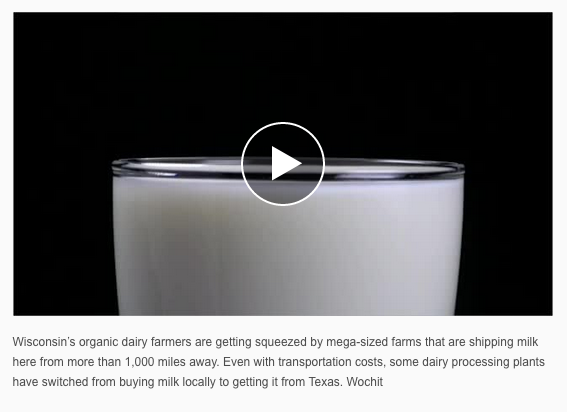USA Today: Wisconsin’s small organic dairies squeezed by Texas mega-farms

by Rick Barrett, Milwaukee Journal Sentinel | March 24, 2018
 MILWAUKEE — You’re in Wisconsin, America’s Dairyland.
MILWAUKEE — You’re in Wisconsin, America’s Dairyland.
You go to the store and buy some organic milk. You have this image of a small farm somewhere in rural Wisconsin, maybe one of those cool little towns in the Kickapoo Valley.
But it could be from a big farm. A really big farm. In Texas.
Yes, Texas.
Wisconsin’s organic dairy farmers are getting squeezed by mega-sized farms that may have more than 100 times as many cows. And while some in Wisconsin claim their oversized brethren aren’t playing by the rules, for the most part, government regulators have dismissed the complaints.
Think of this as the dairy industry version of small-town retailers having Walmart come in and push them to the edge.
For years, farmers have turned to organics to get paid more for their products without as many price fluctuations. But organic dairy has become big business, attracting mega-sized farms in places you wouldn’t think of having them — like west Texas, which is more known for longhorn cattle than Holsteins.
The Texas farms can produce milk cheaper, partly because they buy cattle feed in large quantities grown on thousands of acres. They also can afford to ship milk longer distances, which is important because there aren’t that many people living around cities like Amarillo.
‘Economies of scale’
“It’s economies of scale. Your costs of production go down, and because you’re so big, you’re in a stronger (negotiating) position with processors and wholesalers,” said Steven Deller, a University of Wisconsin-Madison agricultural economist.
Even with transportation costs, some dairy processing plants have switched from buying milk locally to getting it from Texas, according to the U.S. Department of Agriculture’s Dairy Market News.
“The churning within the organic dairy sector continues,” the USDA publication says.
Dairy Market News, based in Madison, Wis., says its information comes from USDA market surveys and other industry sources.
It doesn’t disclose names of farms and processing plants but says six organic dairy farms in Texas produced 481.4 million pounds of milk in 2016, about 23% more than all of Wisconsin’s 453 organic dairy farms combined.
Some Texas dairies have more than 10,000 cows, while Wisconsin’s herd size for organics is often fewer than 100 cows per farm. In average sales, Texas boasts $27.4 million per farm while Wisconsin is just under $278,000, according to USDA data.
Farm size is a “continuing source of friction within the organic dairy industry,” Dairy Market News says.
Overall, it’s more expensive to produce milk under USDA organic rules which call for pesticide-free grain, at least 120 days of pasture access a year, and a significant amount of fresh grass in a cow’s diet.
Organics pay off
Yet the amount that farmers are paid can be nearly double what they would get for nonorganic milk and they can make a living on fewer cows.
“I think it’s still good,” said organic dairy farmer Kevin Thull, who milks about 70 cows on his family farm in Kewaskum, Wis., and sells the milk to Organic Valley Cooperative in LaFarge.
But as the organic market has become saturated, with milk from some very large farms flowing across state lines, some farmers say they’ve lost about 30% of the price they received a couple years ago.
“That’s right off the top, even as our expenses continue to go up,” said Jim Goodman, an organic dairy farmer in Wonewoc, about 70 miles northwest of Madison. “The growth is in the big farms, like in Texas. You don’t see a lot of small organic dairy farms starting up these days.”
He and other Wisconsin dairy farmers say the big operations aren’t following the USDA rules that call for a minimum amount of grazing for organic cows and for the use of certified organic grain.
“We are required to have an acre of pasture per cow, and that’s one of the standards some big farms totally bypass,” said Carla Kostka, owner of Castle Rock Organic Dairy in Osseo.
“If the (USDA) held everyone to the original organic standards, the huge farms couldn’t do it,” Kostka said.
Big is good
The big farms say they’ve met the standards and that they shouldn’t be criticized for their size.
“It is unfortunate that some activists continue to perpetuate the misguided belief that only small dairy farms can be organic,” Aurora Dairy, which has thousands of cows in Texas and Colorado, said in a statement.
Last fall, the USDA closed complaints against Aurora brought by The Cornucopia Institute of Wisconsin and said the mega-sized farm complied with regulations.
Aurora says it manages nearly 12,000 organic pasture acres where its cows graze during the grazing season and that it gets organic grain from more than 100 farms.
“The truth is our size makes a positive difference. … Our scale has also helped create markets for all organic milk producers,” Aurora said.
Aurora spokeswoman Sonja Tuitele said the farm doesn’t ship milk to Wisconsin and that she didn’t know which Texas dairies could be doing that.
Pete Hardin, publisher of The Milkweed, a dairy publication based in Brooklyn, Wis., is among those who remain unconvinced the Texas farms follow the rules.
You couldn’t have thousands of cows grazing in the fields and still get them indoors twice a day for milking, according to Hardin.
“It’s physically impossible for some of these big dairies to call themselves organic and meet the requirements,” he said.
But it’s not unusual for Texas farms to put their milk on trucks for hundreds of miles, said Donald De Jong, co-owner and CEO of Natural Prairie Dairy Farms, located north of Amarillo.
“There’s a misalignment of where milk is and where it needs to be. I think there are a lot of growing pains in organics,” De Jong said.
Natural Prairie has thousands of cows and ships milk about 700 miles south to Houston.
De Jong said Texas farms sending milk to Wisconsin are probably desperate to find a processing plant, given transportation that could add about 20% to the cost of their product.
“I think the market is very weak,” he said, adding that years ago there was a similar situation when Texas dairy farms shipped nonorganic milk to Wisconsin.
In 2017, dozens of dairy farms lost their milk buyer and were nearly forced out of business when Grassland Dairy Products of Greenwood dropped them because it lost millions of dollars of business in Canada.
The clap of thunder
“Looking back, it was the clap of thunder before the storm really started,” Carrie Mess, a dairy farmer from Watertown said Monday in her blog Dairy Carrie.
If nothing changes, Mess said, “Farms are going to be selling cows and going out of the dairy business left and right in the coming months.”
The price farmers have received for nonorganic milk in recent months has been poor, in many cases below the cost of producing it.
“Every day that farms keep the lights on, we go a little further in debt,” Mess said.
In 2016, Wisconsin dairy farmers produced more than 30 billion pounds of milk for the first time, a new record. And while the number of Wisconsin dairy farms has been declining for years — to about 9,000 now from 14,265 in 2007 — milk production has increased as farms have become bigger and more efficient
The production milestone for nonorganic milk came even as the global market was awash in dairy products and prices paid to farmers were depressed from the oversupply.
Farmers “would rather shoot themselves in both feet” than scale back their operations and get a better milk price, Hardin said.
“It’s a classic supply-and-demand squeeze where prices for farmers are collapsing and they are losing their markets because there’s so darn much milk,” he said.
Hardin said he’s seen the price for organic milk drop more than 35% from an earlier high of about $36 per hundred pounds, roughly 12 gallons.
“U.S. organic farmers are on the verge of ruin with these current prices,” Hardin said.